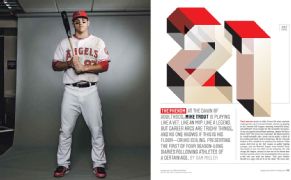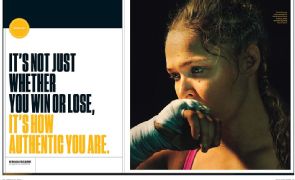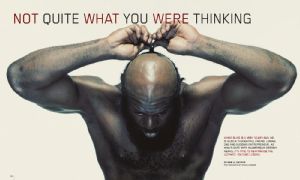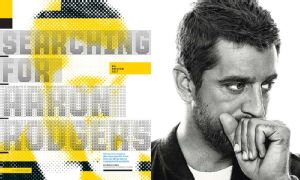|
What's your favorite ESPN The Magazine story ever? That's the excruciatingly hard question we put to our staff, as they put to bed the final issue of our 22-year print run. Their answers ... ALISON OVERHOLT, EDITOR IN CHIEF "So you stand on the curb holding your suitcase and your confusion, deciding what to do next." That's how Tim Keown described a 16-year-old Russell Westbrook in "A Man Apart" (March 27, 2017), recalling the time he'd arrived at a big-time camp but no one knew who he was. The description was so poignant and painful, it's never left me. And it made me feel like I got to see a layer to Westbrook's experience that I had never seen before. That's what a great magazine story does, and Tim Keown has written so many of our best. SCOTT BURTON, EXECUTIVE EDITOR "How They Do in Oxford," an essay by Kiese Laymon (Oct. 26, 2015) on Ole Miss football and the stains of the Confederacy, gives me chills every time I reread it for how daringly it embraces uncomfortable truths, both personal and political. CHIN WANG, SENIOR CREATIVE DIRECTOR "Water's Edge," by Taffy Brodesser-Akner (April 11, 2016), a story on a male synchronized swimmer named Bill May. Lyrical and heartfelt, it will have you rooting for him like he's family by the end. JENA JANOVY, SENIOR DEPUTY EDITOR My father and I agree: The first thing we turn to is Howard Bryant's column, for his perspective on the intersection of sports, race, politics, patriotism and social justice. One in particular stands out, "Divided They Stand," (Sept. 15, 2014), in which he writes: "The chilling chorus of 'stick to sports' ... is not just patronizing; it ignores the reality that sports hasn't been sticking to sports for nearly a generation." RYAN HOCKENSMITH, DEPUTY EDITOR I will always love "The Book of Coach," by Seth Wickersham (Feb. 4, 2013). Seth was able to tell two stories in one powerful feature -- one about the inner torment of Bill Walsh, and another about how Walsh's legacy lives on in a book that has become a secret must-have handbook for wannabe coaches. TY WENGER, DEPUTY EDITOR "The Fix Was in the Whistle," by Scott Eden (March 2019). A master class in journalism that not only proved what had never before been proved-that Tim Donaghy fixed the games he officiated-but achieved an even greater resonance by exploring the degree to which the NBA and other leagues may be all the more susceptible to fixing, given the coming legalization of sports gambling. SUSIE ARTH, SENIOR EDITOR In "At the Corner of Love and Basketball" (June 11, 2012), Allison Glock tells the stories of teen basketball stars Rosalind Ross and Malika Willoughby, who are in love. Over the course of 13 years, they are shunned by family and community but always find their way back to each other. Until, as Glock puts it, "a black hole of reality yawned open, a mirror held to the lie, and Willoughby ... did the only thing she believed she could do to save herself. She killed the dream." AIMEE CRAWFORD, SENIOR EDITOR "Awakening the Giant," Seth Wickersham's Y.A. Tittle profile (July 21, 2014). This story, about how the Hall of Fame QB found fleeting moments of solace with his daughter during a final trip home -- even as his memory faded and his body broke down -- was a tender, compassionate meditation on mortality. The fact that I read it just days after my own father, a former college QB, suffered a stroke that stripped him of his memory made it even more poignant. REBECCA HUDSON, SENIOR EDITOR Peter Keating's portrait of Donald Sterling (June 1, 2009) -- published five years before Sterling's ouster from the NBA -- is The Mag at its very best: rigorous reporting, nuanced writing and astonishing prescience. ERICKA GOODMAN-HUGHEY, SENIOR EDITOR "Game of Her Life," by Tim Crothers (Jan. 10, 2011), the story of a chess prodigy from Uganda. "To be African is to be an underdog in the world. To be Ugandan is to be an underdog in Africa. To be from Katwe is to be an underdog in Uganda. And finally, to be female is to be an underdog in Katwe," Crothers writes. Yet, Phiona Mutesi won. It wasn't a sport-as-the-savior tale. The piece spoke to her humanity and that of Katwe. ROSS MARRINSON, SENIOR EDITOR "The Losers' Guide to Winning," by Pablo Torre (March 2, 2015). When Pablo told us he'd gotten exactly one on-the-record quote for this story from then-Sixers GM Sam Hinkie, we were ... nervous. But then he filed his story, which revealed every conceivable angle behind the most audacious experiment in sports history. You might dislike tanking. But after reading this article (and seeing the stars the Sixers have now), you can't deny the method behind what so many decried as madness.  RACHEL ULLRICH, SENIOR EDITOR Way back in October 2012, Sam Miller wrote his first story about Mike Trout for the Magazine. He's written dozens since on the best player in baseball, but this one -- which also introduced us to the origins of the Millville Meteor nickname: an internet commenter named Weed Mouse(!) -- remains my favorite. DOTUN AKINTOYE, GENERAL EDITOR Hallie Grossman's gift is that she treats her subjects with real care, she pays attention. And so, in "Money Brawl" (December 2018), we see why Cris Cyborg is unique, and perhaps uniquely trapped; but we also see the way in which her UFC career symbolizes the plight of so many women in MMA. And because Hallie resists glibness and rote thinking and cheap sentiment, she diagrams the complexity of the situation - all the ways the UFC and the media and the audience and the fighters themselves are implicated and at cross purposes. No one escapes unscathed. It's a wonderful portrait that succeeds the way the best profiles do; you reach the end satisfied but thinking, "I wonder where this story will go next?" ELAINE TENG, GENERAL EDITOR "We Live Baseball," the interview project of 46 Latino baseball players from the Béisbol Experience Issue (June 26, 2017). It's one of the best examples of how this magazine could examine a slice of life, in all its complexity. The quotes are funny, sad, moving, individual even as they build to capture a shared experience that is, of course, more relevant than ever. JENISHA WATTS, ASSOCIATE EDITOR "Ode to the Girl on a Wheel," by Nikky Finney (Oct. 31, 2016). Look, a freaking poem was printed in The Magazine, a testament to the unconventional ways we experimented with storytelling. This line still rattles in my head: "... the lanky girls, who uncrossed their legs, who rode by emancipated on their wheels ..."  STACEY PRESSMAN, CONTRIBUTING EDITOR Ronda Rousey was one of the biggest, most confident mainstream superstars when Ramona Shelburne negotiated unprecedented access to profile her for our year-end issue (Dec. 15, 2015). The cover story set out to chronicle this feminist hero with the Hollywood hype and the 'DNB T's' but a stunning defeat toward the close of The Magazine set the story on different path, one that rocked both Ronda's face (she couldn't bite into an apple for six months) and her confidence. Ramona was left to deftly navigate an athlete who was having a career crisis. WAYNE DREHS, SENIOR WRITER I'm going with Mina Kimes' "The Search for Aaron Rodgers" (Sept. 18, 2017). The Packers quarterback is one of the most guarded stars of this generation. Enter Mina, who sits on her living room couch with Rodgers, watches him critique the contents of her apartment and while doing so watches the fence come down so she can masterfully reveal Rodgers as something most anyone can relate to: a middle-aged man struggling to grasp his place in the world. DAVID FLEMING, SENIOR WRITER For me, the Michael Vick Issue (Sept. 5, 2011) represents The Mag at its very best: bold, brave, creative, collaborative and a little crazy. The only time we ever dedicated an entire issue to one person resulted in amazing, tireless work by dozens of people, a National Magazine Award nomination and an epic expense report that included a PayPal charge for a private jet so Seth Wickersham and I could get one-on-one time with Vick. BONNIE D. FORD, SENIOR WRITER "The Greatest, At Rest," Tom Junod's story on Muhammad Ali's burial (June 12, 2017), a masterful reporting and writing job by our modern master. I read it in three takes and didn't want it to be over. ALLISON GLOCK, SENIOR WRITER When Alyssa Roenigk writes about something -- anything -- you can count on her sensitivity, empathy and (very un-writerly) lack of ego informing the story. This was never more true than when she reported on freeskier Gus Kenworthy's coming out (Nov. 9, 2015), a piece that told a vital story, made a huge impact and did it all with a grace uncommon not just in sports journalism but in all prose. Roenigk showed why restraint always trumps shouting, and why listening with an open, welcoming heart is the most vital reporting skill of all. TOM JUNOD, SENIOR WRITER I'm not sure if Wright Thompson's great profile of Urban Meyer (Aug. 20, 2012) is my favorite story from The Magazine in terms of appreciation. It is, however, the most influential one in terms of my behavior. Simply put, the moment when Meyer's volleyball-star daughter celebrates her college signing day by giving a speech thanking everyone who supported her -- and then singles out her father for not supporting her and not going to her games -- is one of the most terrifying things this father of a high school softball player has ever read. I have never missed a game without thinking of it, and I have missed precious few games because of it. I owe Wright and ESPN The Magazine for many, many hours as a captivated reader. But I owe Nicki Meyer for my B+ in attendance. TIM KEOWN, SENIOR WRITER Tommy Tomlinson's deeply reported, fun, sad, personal, prescient, weird 2014 story on Jared Lorenzen (Sept. 1, 2014). Like countless others, it was the type of story you could only find here. MINA KIMES, SENIOR WRITER I often think about "When 772 Pitches Isn't Enough," Chris Jones' story on Tomohiru Anraku, the Japanese pitching phenom (July 22, 2013). I read the story on a train ride to Connecticut for my job interview with The Magazine, and it affirmed my desire to start writing about sports. RYAN McGEE, SENIOR WRITER A decade later I'm still laughing at the story of Sam Alipour ambushing Tom Cruise at Auto Club Speedway with Days of Thunder questions (March 24, 2008), especially the closing line: "He lets go of my hand, then turns away to sign more autographs, still smiling. I stand there for several minutes, like a creep, watching him." ELIZABETH MERRILL, SENIOR WRITER David Fleming's story on former NFL receiver Reche Caldwell (May 23, 2016). When you can recite full sentences from something you read years ago, you know it's a memorable story ... His head stays bowed like that for a long time, until he's asked to explain exactly how he went from the Patriots to prison, how he transitioned from being the best receiver in New England to the worst drug kingpin in Tampa ... "I Googled it, baby!" ALYSSA ROENIGK, SENIOR WRITER Since "any profile by Tim Keown" likely isn't a specific enough answer, I did the impossible and chose one: Tim's profile of Raiders owner Mark Davis (Oct. 12, 2015), he of the "Roman centurion bowl cut" and "cartoon villain laugh." WRIGHT THOMPSON, SENIOR WRITER "The Mismatch," Tom Friend's Tommy Morrison story from our very first issue (March 23, 1998), because it served noticed both to Sports Illustrated that they had competition on the block and to young writers (say, in college, like me) that there was a home for the ambitious stories we dreamed of writing.  DON VAN NATTA JR., SENIOR WRITER There's no such thing as a perfect story -- and that applies to Wright Thompson's astonishing profile of Michael Jordan at 50 (March 4, 2013). I would have liked some discussion of MJ's gambling habit and history. But this is Wright's masterpiece and comes as close to a perfect profile as any piece I've ever read. KEVIN VAN VALKENBURG, SENIOR WRITER "Why Him, Why Me" by Eli Saslow (Nov. 23, 2015). The best magazine stories are always ones with moral ambiguity and few, if any, do that better than Eli Saslow. His haunting story about the bond shared by two men, a generation apart, who took someone's life playing football will stick with me forever. SETH WICKERSHAM, SENIOR WRITER Dan Le Batard's story on 14-year-old Danny Almonte (Dec. 24, 2001), who had found himself at the center of an international Little League Baseball cheating scandal. The first sentence is "So much got lost in the translation," which was perfect because the story was not only about the translation from Spanish to English, but from the Dominican Republic to America, and the chance at a better life that sports can provide -- and the desperate lengths a parent will go to in the hopes of securing it for their child. STEVE WULF, SENIOR WRITER "You Can't Quit Cold Turkey," by Tommy Tomlinson (Sept. 1, 2014). When Jared Lorenzen passed away recently, I went back to Tommy Tomlinson's poignant profile of the portly quarterback that is both light and heavy at the same time -- a paradox manifested by Lorenzen himself. It also has one of the best leads I have ever read: "Jared Lorenzen and I are in love with the same woman. Her name is Little Debbie ..." HALLIE GROSSMAN, WRITER/REPORTER "A Tree Dies in Auburn," Wright Thompson's story on Toomer's Corner (Aug. 22, 2011). I've never been to Auburn. Never stood at Toomer's Corner or rolled the oaks where College Street and Magnolia Avenue intersected. But I have a place too -- a college, a team -- and a family bound by that place. And because Wright wrote so lovingly, so universally, I understood why so many Auburn fans cried over a pair of felled oak trees. I cried too. BAXTER HOLMES, CONTRIBUTING WRITER "True Lies," by Eric Adelson, the story of a basketball coach who was accused of sexually abusing several of his players (Jan. 31, 2005). This was the first story that grabbed me by the throat. I begged everyone I knew to read it; they all had the same reaction. And it inspired me to try to write stories as captivating as this one. LINDA ROOT POUDER, ASSOCIATE ART DIRECTOR The investigative reporting in "The Enablers of Larry Nassar," by John Barr and Dan Murphy (Feb. 5, 2018), cracked open to the world secrets that too many were hiding. Commissioning illustration for sensitive topics is always tough, but Mark Smith gave me his best here. I was proud to work on this one. MUNEHITO SAWADA, ASSOCIATE ART DIRECTOR "The Dictator's Team," by Steve Fainaru (May 29, 2017), which details how Bashar al-Assad's government in Syria has torn apart a generation of soccer players. This is one of our extraordinary stories that amplified unheard voices and hopefully made a difference to the world. KAREN FRANK, DIRECTOR OF PHOTOGRAPHY "Junior Seau -- a Life in Pictures" (April 15, 2013). We had the unique opportunity to visit with Junior's wife not long after his death and were given access to never-before-seen photographs of him in his youth and with his family. The collection of images tells a story of the promise of his youth, the sad and abrupt conclusion of his life and the grief in the aftermath of his death.  JIM SURBER, DEPUTY PHOTO EDITOR Dan LeBatard's cover profile of Kimbo Slice (June 2, 2008), who, if you were to believe the internet, was a terrifying backyard brawler but in reality was a man simply fighting to bring himself up out of homelessness and grow as a human being. NICK GALAC, SENIOR PHOTO EDITOR "Neither Royal Nor Ancient," a photo essay by photographer Claire Martin (July 20, 2015), which memorably highlighted a unique and absurd connection between famed St. Andrews and a golf course in the Australian Outback. KRISTINE LAMANNA, SENIOR PHOTO EDITOR The imagery for our One Day, One Game issues, particularly the one we did on the Heat and the Bulls (April 16, 2012), was always exciting; it gave us all a behind-the-scenes look into the day and showcased the exhilarating world of sports. KAITLIN MARRON, GENERAL PHOTO EDITOR "Flying Horses Don't Come Cheap" (Dec. 8, 2014), an exclusive behind-the-scenes look at the LA leg of the Masters Grand Slam of show jumping. I am a sucker for everything equine, and this assignment felt like going to a horsey Super Bowl! CHRISTIAN ROGERS, DIRECTOR, EDITORIAL OPERATIONS & COPY Steve Wulf's essay following 9/11 (Oct. 1, 2001) is still the most moving piece we have done. I remember that week that I questioned why we were in the office producing a magazine, considering the horror playing out not far from our office door. But I also remember that his words and those pages were our way of helping all of us get through that time, reminding us that heroes had always been among us and that with time we could, and had to, move forward. STEVE GORDON, COPY DESK CHIEF Many important, groundbreaking pieces of journalism have been published in The Mag, and Baxter Holmes' story on the NBA's obsession with PB&J sandwiches (March 27, 2017) ... wasn't one of them. But this story ranked a 10 on the freshness scale and created more buzz around the office than maybe any other I can think of. I ate it up. JOHN MASTROBERARDINO, MANAGER, OPERATIONS & RESEARCH "While the World Watched," Wright Thompson's piece on the dictatorship in Argentina during the 1978 FIFA World Cup (June 23, 2014). As the researcher on the story, I had a chance to speak to some of the survivors. I was struck by their humility, yet each commanded admiration and respect for what they endured. TARYN AYOTTE, EDIT OPERATIONS COORDINATOR I loved the photo feature in which we asked athletes to re-create classic album covers (Feb. 18, 2013). I had just started my career here, and it was incredibly exciting to be working on such a unique issue. I had never seen anything like it before, and I thought it was such a smart concept. GUEORGUI MILKOV, RESEARCH CHIEF "While the World Watched," Wright Thompson's story about Argentina's Dirty War and the 1978 FIFA World Cup (June 23, 2014). While traveling around this beautiful country recently, I met many fútbol-mad folks, including a local guide, who told me that to him as a huge Albiceleste fan, the 1978 World Cup should not really count for Argentina because of all the corruption allegations and match fixing and, most importantly, the grim legacy of the military junta. That is exactly the essence of what happened in 1978, and Wright was able to capture it in his deeply moving story. SACHIN DAVE CHANDAN, REPORTER/RESEARCHER Eddie Matz's feature on Brandon McCarthy, a pitcher who embraced the use of analytics (March 5, 2012). At the time, I knew sports analytics would be an interest of mine, but what changed me reading the piece was how well it told a fascinating, fun story while making the esoteric feel relatable. DAN HAJDUCKY, REPORTER/RESEARCHER "The FBI vs. FIFA," by Shaun Assael and Brett Forrest (Feb. 29, 2016), which chronicled Chuck Blazer's corruption and subsequent plummet as FIFA turncoat. The visage of a 400-pound, adult-diaper-clad millionaire racketeer ogling the Manhattan skyline from his penthouse while FBI agents wire his torso is quintessential ESPN The Magazine. CHARLOTTE GIBSON, REPORTER/RESEARCHER Every time I look at "If Not for Them" (July 30, 2018), I get chills. It showcased 12 of the brave women who were among the hundreds of sister survivors who came forward about the abuse they endured from Larry Nassar. These images and interviews truly embody strength and power. I'll forever be grateful that these women shared their stories with us. ANTHONY OLIVIERI, REPORTER/RESEARCHER "Blaze of Glory," by David Fleming (Sept. 30, 2013). The Packers were saved from ruin by the insurance money collected after their training facility burned down in 1950. Aaaaand ... they might have torched it themselves. One part whodunit, one part history lesson, Flem examined the NFL's present through a little-known event in its past. JAY JAY NESHEIM, SENIOR DIRECTOR, COMMUNICATIONS "Revis, Party of One," Mina Kimes' Darrelle Revis profile (Aug. 31, 2015). Revis was always an intriguing player to me as a Jets fan, and I felt like Mina's story gave me a lot more insight into him as a person.  STEPHANIE FALLON, ASSOCIATE MANAGER, PREPRESS & DIGITAL PRODUCTION Mina Kimes' profile of Aaron Rodgers (Sept 18, 2017). How do you pull off a Hail Mary? Planning, timing, trust and, ultimately, execution. Whether it's a last-second midfield heave over Lambeau's tundra or Mina's 2017 profile of the NFL's most enigmatic QB, the encapsulation of Aaron Rodgers comes down to balance. Preparation? Meet opportunity. DAVID KARATZ, DIRECTOR, PUBLISHING "The Secret History of Tiger Woods," by Wright Thompson (May 9, 2016). Tiger's real-life saga is better than any scripted sports drama ever. Right when we were thinking "what's next," Wright unearthed something special from the past that blew all of us readers away.
|

